Aromatic Condiment Shop: Japanese Business Etiquette Analysis
VerifiedAdded on 2020/03/04
|7
|1935
|240
Essay
AI Summary
This essay provides a strategic analysis of Japanese business etiquette, cultural dimensions, and their implications for the Aromatic Condiment Shop's planned expansion into the Japanese market. It explores the importance of understanding cultural nuances, including dress code, social interactions, and respect for elders, in order to avoid misunderstandings and build strong business relationships. The essay delves into Hofstede's cultural dimension theory and the GLOBE model to assess how these frameworks can inform market entry strategies, communication tactics, and leadership approaches. It highlights the challenges faced by a female entrepreneur in a business environment where men traditionally dominate. Furthermore, it emphasizes the role of corporate social responsibility and the importance of adapting marketing tactics, such as leveraging social media and e-commerce, to resonate with the target consumer base. Ultimately, the essay concludes that success in the Japanese market requires more than just learning the language; it demands an understanding and appreciation of the national culture's values and etiquette.
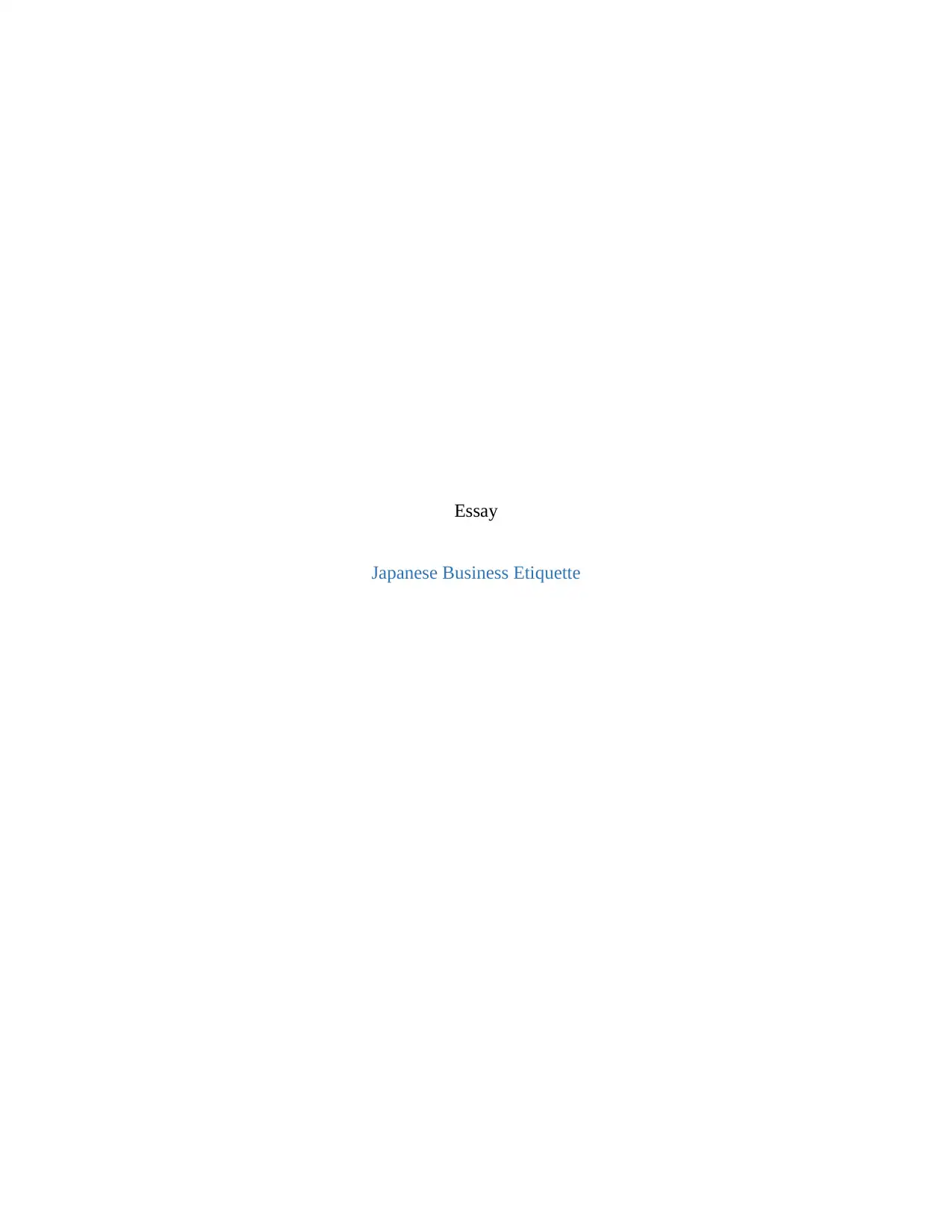
Essay
Japanese Business Etiquette
Japanese Business Etiquette
Paraphrase This Document
Need a fresh take? Get an instant paraphrase of this document with our AI Paraphraser
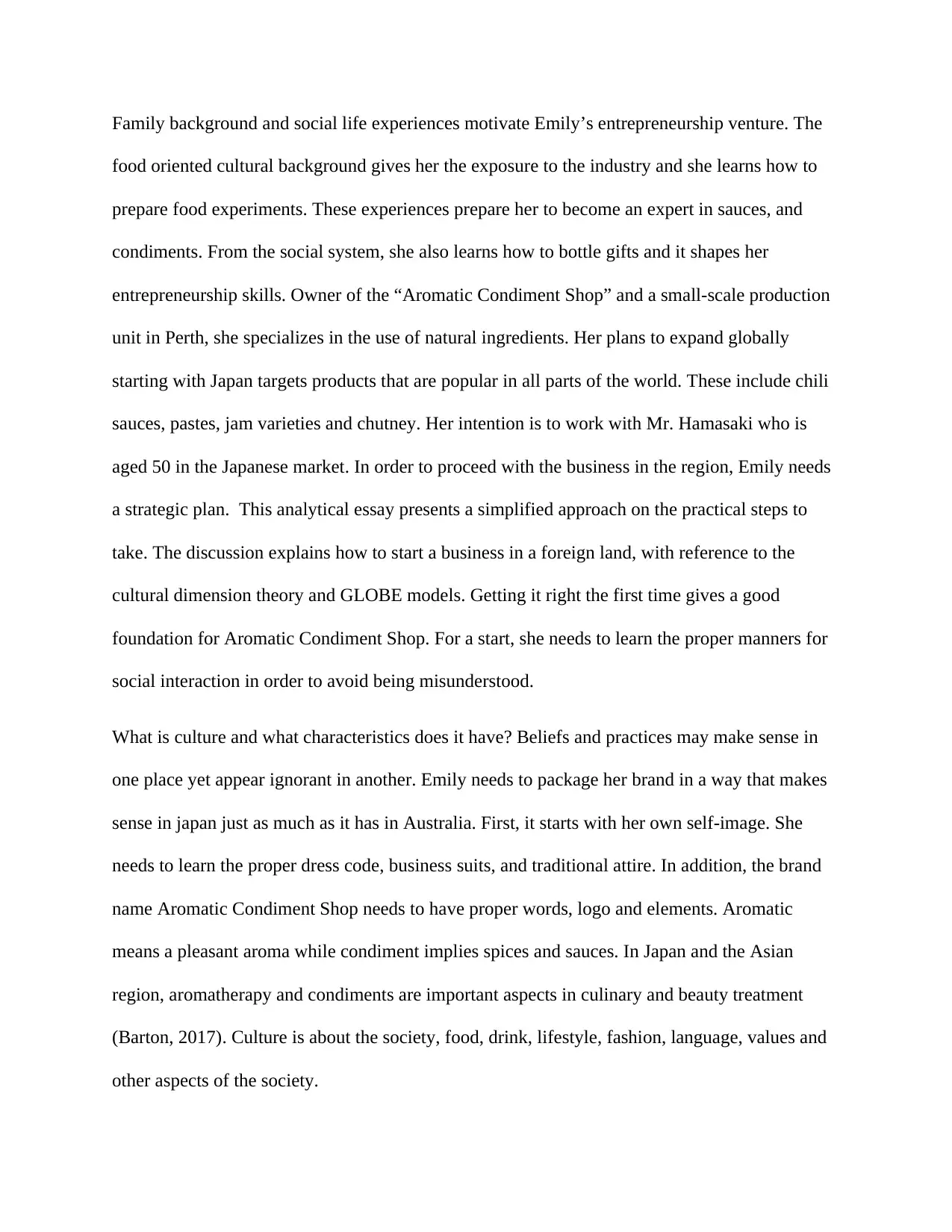
Family background and social life experiences motivate Emily’s entrepreneurship venture. The
food oriented cultural background gives her the exposure to the industry and she learns how to
prepare food experiments. These experiences prepare her to become an expert in sauces, and
condiments. From the social system, she also learns how to bottle gifts and it shapes her
entrepreneurship skills. Owner of the “Aromatic Condiment Shop” and a small-scale production
unit in Perth, she specializes in the use of natural ingredients. Her plans to expand globally
starting with Japan targets products that are popular in all parts of the world. These include chili
sauces, pastes, jam varieties and chutney. Her intention is to work with Mr. Hamasaki who is
aged 50 in the Japanese market. In order to proceed with the business in the region, Emily needs
a strategic plan. This analytical essay presents a simplified approach on the practical steps to
take. The discussion explains how to start a business in a foreign land, with reference to the
cultural dimension theory and GLOBE models. Getting it right the first time gives a good
foundation for Aromatic Condiment Shop. For a start, she needs to learn the proper manners for
social interaction in order to avoid being misunderstood.
What is culture and what characteristics does it have? Beliefs and practices may make sense in
one place yet appear ignorant in another. Emily needs to package her brand in a way that makes
sense in japan just as much as it has in Australia. First, it starts with her own self-image. She
needs to learn the proper dress code, business suits, and traditional attire. In addition, the brand
name Aromatic Condiment Shop needs to have proper words, logo and elements. Aromatic
means a pleasant aroma while condiment implies spices and sauces. In Japan and the Asian
region, aromatherapy and condiments are important aspects in culinary and beauty treatment
(Barton, 2017). Culture is about the society, food, drink, lifestyle, fashion, language, values and
other aspects of the society.
food oriented cultural background gives her the exposure to the industry and she learns how to
prepare food experiments. These experiences prepare her to become an expert in sauces, and
condiments. From the social system, she also learns how to bottle gifts and it shapes her
entrepreneurship skills. Owner of the “Aromatic Condiment Shop” and a small-scale production
unit in Perth, she specializes in the use of natural ingredients. Her plans to expand globally
starting with Japan targets products that are popular in all parts of the world. These include chili
sauces, pastes, jam varieties and chutney. Her intention is to work with Mr. Hamasaki who is
aged 50 in the Japanese market. In order to proceed with the business in the region, Emily needs
a strategic plan. This analytical essay presents a simplified approach on the practical steps to
take. The discussion explains how to start a business in a foreign land, with reference to the
cultural dimension theory and GLOBE models. Getting it right the first time gives a good
foundation for Aromatic Condiment Shop. For a start, she needs to learn the proper manners for
social interaction in order to avoid being misunderstood.
What is culture and what characteristics does it have? Beliefs and practices may make sense in
one place yet appear ignorant in another. Emily needs to package her brand in a way that makes
sense in japan just as much as it has in Australia. First, it starts with her own self-image. She
needs to learn the proper dress code, business suits, and traditional attire. In addition, the brand
name Aromatic Condiment Shop needs to have proper words, logo and elements. Aromatic
means a pleasant aroma while condiment implies spices and sauces. In Japan and the Asian
region, aromatherapy and condiments are important aspects in culinary and beauty treatment
(Barton, 2017). Culture is about the society, food, drink, lifestyle, fashion, language, values and
other aspects of the society.
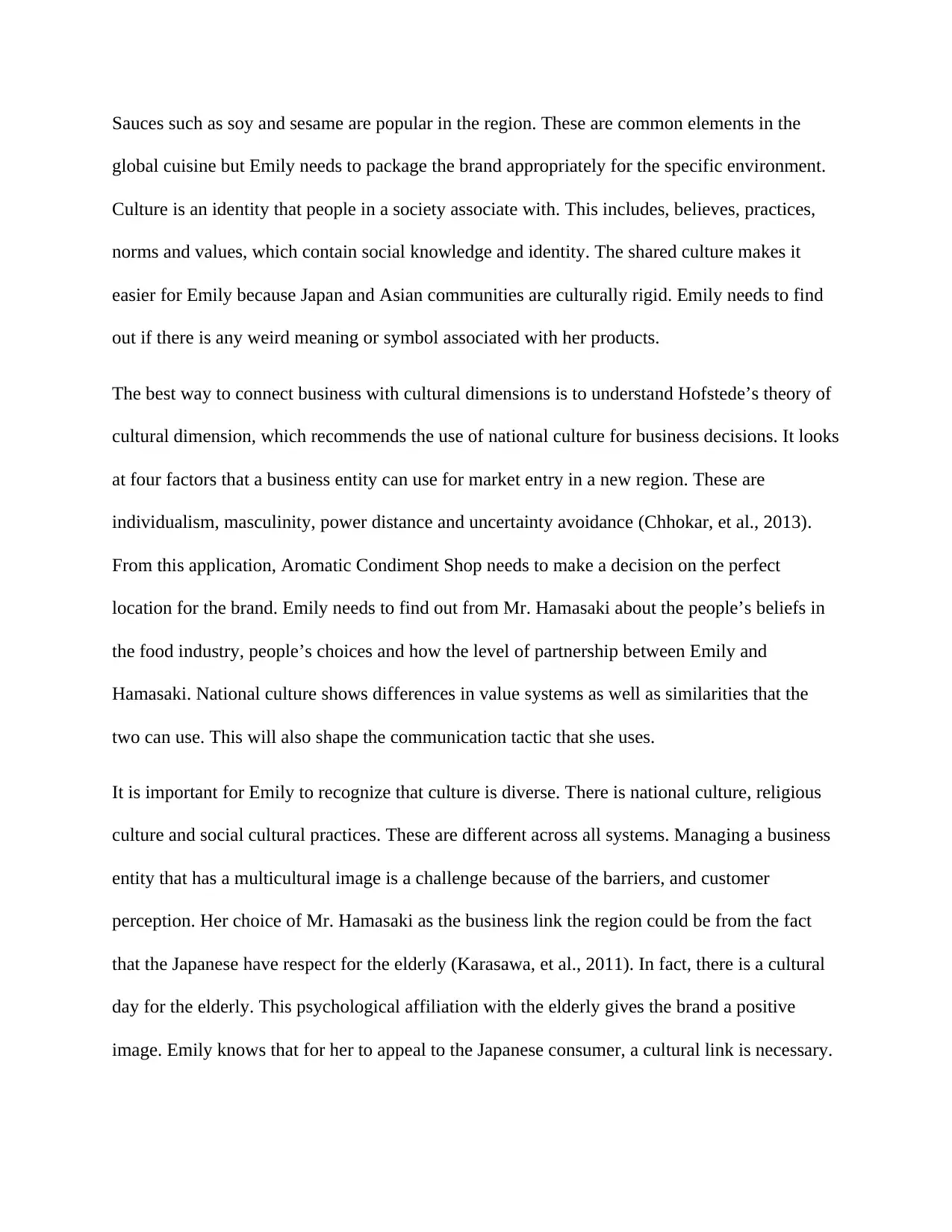
Sauces such as soy and sesame are popular in the region. These are common elements in the
global cuisine but Emily needs to package the brand appropriately for the specific environment.
Culture is an identity that people in a society associate with. This includes, believes, practices,
norms and values, which contain social knowledge and identity. The shared culture makes it
easier for Emily because Japan and Asian communities are culturally rigid. Emily needs to find
out if there is any weird meaning or symbol associated with her products.
The best way to connect business with cultural dimensions is to understand Hofstede’s theory of
cultural dimension, which recommends the use of national culture for business decisions. It looks
at four factors that a business entity can use for market entry in a new region. These are
individualism, masculinity, power distance and uncertainty avoidance (Chhokar, et al., 2013).
From this application, Aromatic Condiment Shop needs to make a decision on the perfect
location for the brand. Emily needs to find out from Mr. Hamasaki about the people’s beliefs in
the food industry, people’s choices and how the level of partnership between Emily and
Hamasaki. National culture shows differences in value systems as well as similarities that the
two can use. This will also shape the communication tactic that she uses.
It is important for Emily to recognize that culture is diverse. There is national culture, religious
culture and social cultural practices. These are different across all systems. Managing a business
entity that has a multicultural image is a challenge because of the barriers, and customer
perception. Her choice of Mr. Hamasaki as the business link the region could be from the fact
that the Japanese have respect for the elderly (Karasawa, et al., 2011). In fact, there is a cultural
day for the elderly. This psychological affiliation with the elderly gives the brand a positive
image. Emily knows that for her to appeal to the Japanese consumer, a cultural link is necessary.
global cuisine but Emily needs to package the brand appropriately for the specific environment.
Culture is an identity that people in a society associate with. This includes, believes, practices,
norms and values, which contain social knowledge and identity. The shared culture makes it
easier for Emily because Japan and Asian communities are culturally rigid. Emily needs to find
out if there is any weird meaning or symbol associated with her products.
The best way to connect business with cultural dimensions is to understand Hofstede’s theory of
cultural dimension, which recommends the use of national culture for business decisions. It looks
at four factors that a business entity can use for market entry in a new region. These are
individualism, masculinity, power distance and uncertainty avoidance (Chhokar, et al., 2013).
From this application, Aromatic Condiment Shop needs to make a decision on the perfect
location for the brand. Emily needs to find out from Mr. Hamasaki about the people’s beliefs in
the food industry, people’s choices and how the level of partnership between Emily and
Hamasaki. National culture shows differences in value systems as well as similarities that the
two can use. This will also shape the communication tactic that she uses.
It is important for Emily to recognize that culture is diverse. There is national culture, religious
culture and social cultural practices. These are different across all systems. Managing a business
entity that has a multicultural image is a challenge because of the barriers, and customer
perception. Her choice of Mr. Hamasaki as the business link the region could be from the fact
that the Japanese have respect for the elderly (Karasawa, et al., 2011). In fact, there is a cultural
day for the elderly. This psychological affiliation with the elderly gives the brand a positive
image. Emily knows that for her to appeal to the Japanese consumer, a cultural link is necessary.
⊘ This is a preview!⊘
Do you want full access?
Subscribe today to unlock all pages.

Trusted by 1+ million students worldwide
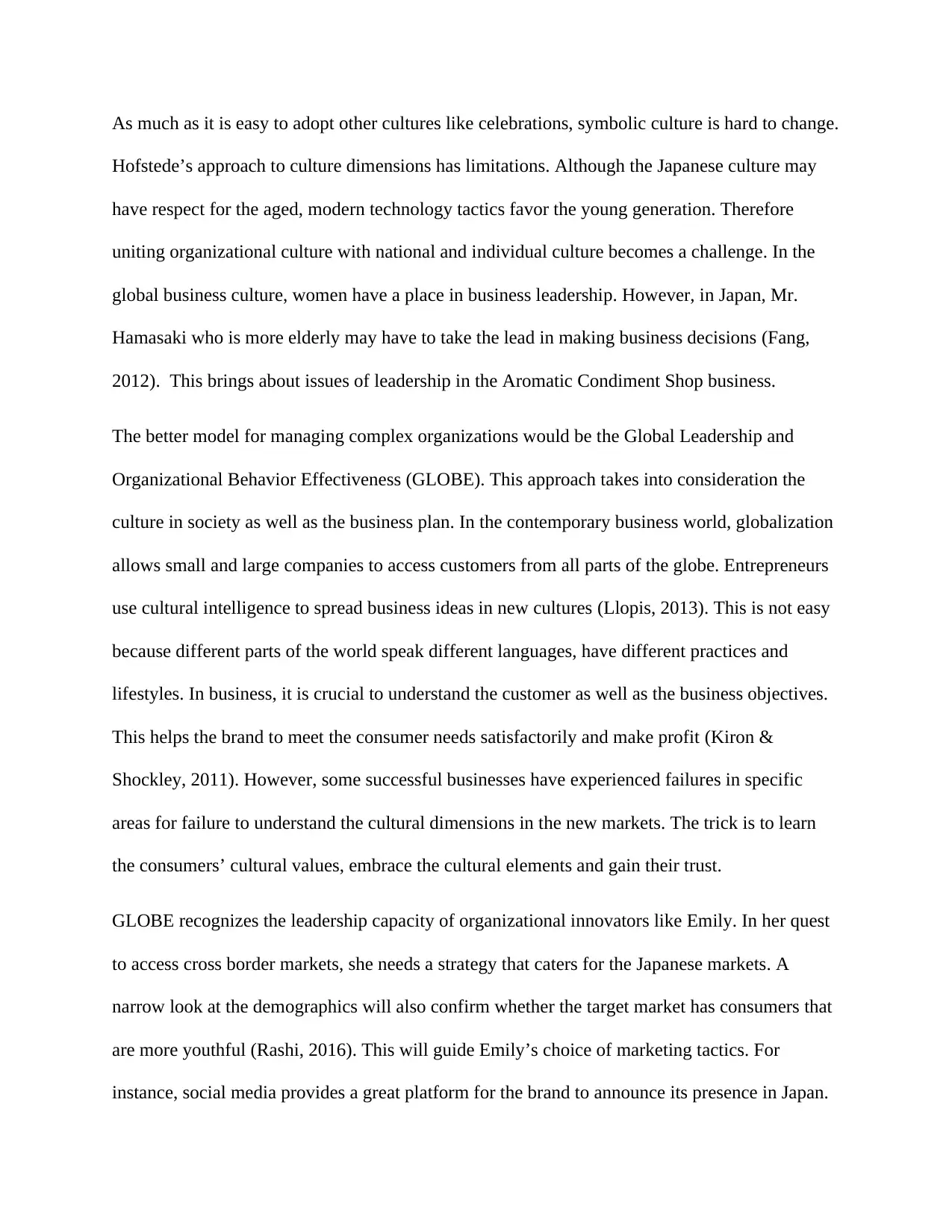
As much as it is easy to adopt other cultures like celebrations, symbolic culture is hard to change.
Hofstede’s approach to culture dimensions has limitations. Although the Japanese culture may
have respect for the aged, modern technology tactics favor the young generation. Therefore
uniting organizational culture with national and individual culture becomes a challenge. In the
global business culture, women have a place in business leadership. However, in Japan, Mr.
Hamasaki who is more elderly may have to take the lead in making business decisions (Fang,
2012). This brings about issues of leadership in the Aromatic Condiment Shop business.
The better model for managing complex organizations would be the Global Leadership and
Organizational Behavior Effectiveness (GLOBE). This approach takes into consideration the
culture in society as well as the business plan. In the contemporary business world, globalization
allows small and large companies to access customers from all parts of the globe. Entrepreneurs
use cultural intelligence to spread business ideas in new cultures (Llopis, 2013). This is not easy
because different parts of the world speak different languages, have different practices and
lifestyles. In business, it is crucial to understand the customer as well as the business objectives.
This helps the brand to meet the consumer needs satisfactorily and make profit (Kiron &
Shockley, 2011). However, some successful businesses have experienced failures in specific
areas for failure to understand the cultural dimensions in the new markets. The trick is to learn
the consumers’ cultural values, embrace the cultural elements and gain their trust.
GLOBE recognizes the leadership capacity of organizational innovators like Emily. In her quest
to access cross border markets, she needs a strategy that caters for the Japanese markets. A
narrow look at the demographics will also confirm whether the target market has consumers that
are more youthful (Rashi, 2016). This will guide Emily’s choice of marketing tactics. For
instance, social media provides a great platform for the brand to announce its presence in Japan.
Hofstede’s approach to culture dimensions has limitations. Although the Japanese culture may
have respect for the aged, modern technology tactics favor the young generation. Therefore
uniting organizational culture with national and individual culture becomes a challenge. In the
global business culture, women have a place in business leadership. However, in Japan, Mr.
Hamasaki who is more elderly may have to take the lead in making business decisions (Fang,
2012). This brings about issues of leadership in the Aromatic Condiment Shop business.
The better model for managing complex organizations would be the Global Leadership and
Organizational Behavior Effectiveness (GLOBE). This approach takes into consideration the
culture in society as well as the business plan. In the contemporary business world, globalization
allows small and large companies to access customers from all parts of the globe. Entrepreneurs
use cultural intelligence to spread business ideas in new cultures (Llopis, 2013). This is not easy
because different parts of the world speak different languages, have different practices and
lifestyles. In business, it is crucial to understand the customer as well as the business objectives.
This helps the brand to meet the consumer needs satisfactorily and make profit (Kiron &
Shockley, 2011). However, some successful businesses have experienced failures in specific
areas for failure to understand the cultural dimensions in the new markets. The trick is to learn
the consumers’ cultural values, embrace the cultural elements and gain their trust.
GLOBE recognizes the leadership capacity of organizational innovators like Emily. In her quest
to access cross border markets, she needs a strategy that caters for the Japanese markets. A
narrow look at the demographics will also confirm whether the target market has consumers that
are more youthful (Rashi, 2016). This will guide Emily’s choice of marketing tactics. For
instance, social media provides a great platform for the brand to announce its presence in Japan.
Paraphrase This Document
Need a fresh take? Get an instant paraphrase of this document with our AI Paraphraser
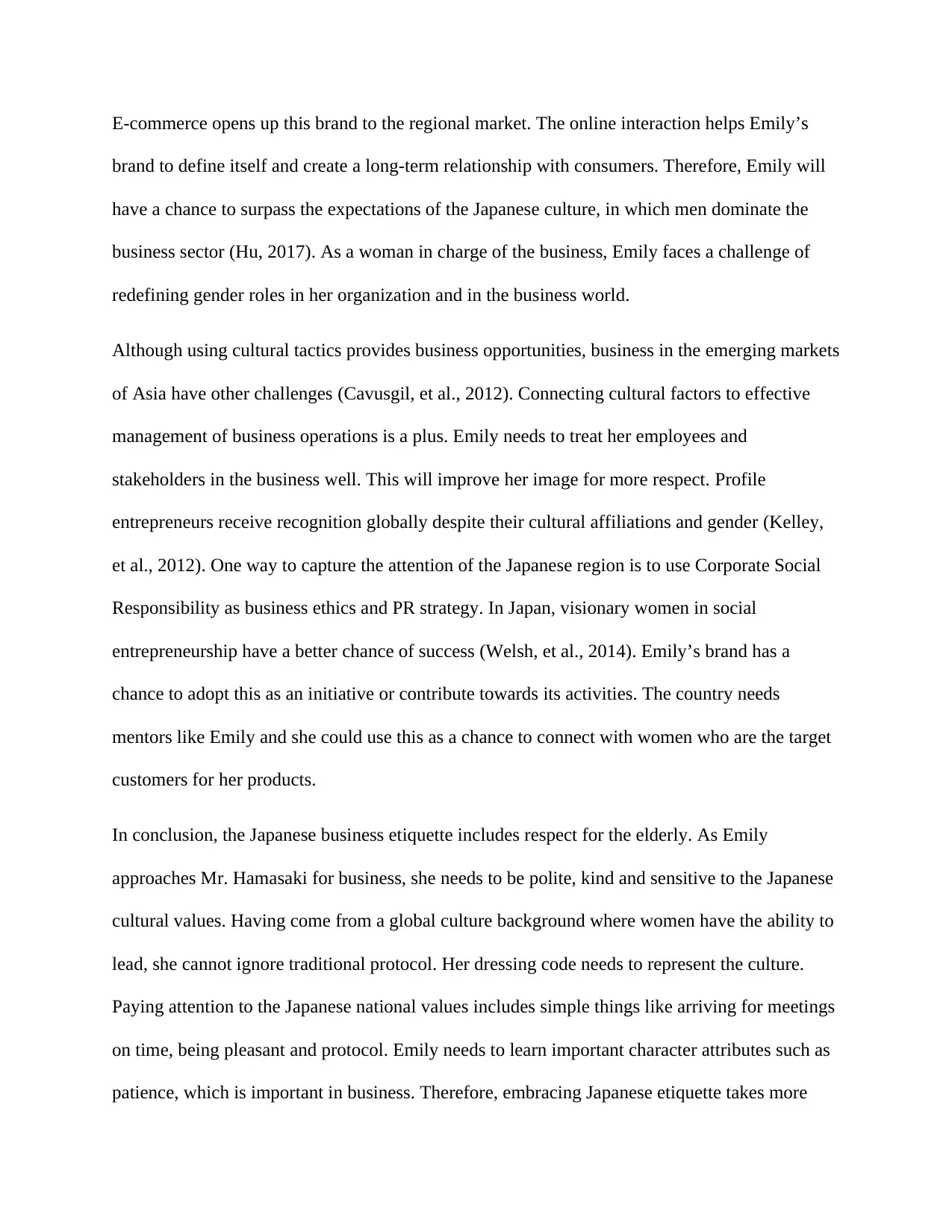
E-commerce opens up this brand to the regional market. The online interaction helps Emily’s
brand to define itself and create a long-term relationship with consumers. Therefore, Emily will
have a chance to surpass the expectations of the Japanese culture, in which men dominate the
business sector (Hu, 2017). As a woman in charge of the business, Emily faces a challenge of
redefining gender roles in her organization and in the business world.
Although using cultural tactics provides business opportunities, business in the emerging markets
of Asia have other challenges (Cavusgil, et al., 2012). Connecting cultural factors to effective
management of business operations is a plus. Emily needs to treat her employees and
stakeholders in the business well. This will improve her image for more respect. Profile
entrepreneurs receive recognition globally despite their cultural affiliations and gender (Kelley,
et al., 2012). One way to capture the attention of the Japanese region is to use Corporate Social
Responsibility as business ethics and PR strategy. In Japan, visionary women in social
entrepreneurship have a better chance of success (Welsh, et al., 2014). Emily’s brand has a
chance to adopt this as an initiative or contribute towards its activities. The country needs
mentors like Emily and she could use this as a chance to connect with women who are the target
customers for her products.
In conclusion, the Japanese business etiquette includes respect for the elderly. As Emily
approaches Mr. Hamasaki for business, she needs to be polite, kind and sensitive to the Japanese
cultural values. Having come from a global culture background where women have the ability to
lead, she cannot ignore traditional protocol. Her dressing code needs to represent the culture.
Paying attention to the Japanese national values includes simple things like arriving for meetings
on time, being pleasant and protocol. Emily needs to learn important character attributes such as
patience, which is important in business. Therefore, embracing Japanese etiquette takes more
brand to define itself and create a long-term relationship with consumers. Therefore, Emily will
have a chance to surpass the expectations of the Japanese culture, in which men dominate the
business sector (Hu, 2017). As a woman in charge of the business, Emily faces a challenge of
redefining gender roles in her organization and in the business world.
Although using cultural tactics provides business opportunities, business in the emerging markets
of Asia have other challenges (Cavusgil, et al., 2012). Connecting cultural factors to effective
management of business operations is a plus. Emily needs to treat her employees and
stakeholders in the business well. This will improve her image for more respect. Profile
entrepreneurs receive recognition globally despite their cultural affiliations and gender (Kelley,
et al., 2012). One way to capture the attention of the Japanese region is to use Corporate Social
Responsibility as business ethics and PR strategy. In Japan, visionary women in social
entrepreneurship have a better chance of success (Welsh, et al., 2014). Emily’s brand has a
chance to adopt this as an initiative or contribute towards its activities. The country needs
mentors like Emily and she could use this as a chance to connect with women who are the target
customers for her products.
In conclusion, the Japanese business etiquette includes respect for the elderly. As Emily
approaches Mr. Hamasaki for business, she needs to be polite, kind and sensitive to the Japanese
cultural values. Having come from a global culture background where women have the ability to
lead, she cannot ignore traditional protocol. Her dressing code needs to represent the culture.
Paying attention to the Japanese national values includes simple things like arriving for meetings
on time, being pleasant and protocol. Emily needs to learn important character attributes such as
patience, which is important in business. Therefore, embracing Japanese etiquette takes more

than getting to know the language. It also comprises of basic personality factors that people in
the national culture can appreciate. Business acumen in the global markets cannot succeed
without paying attention to cultural diversities in the multinational brands. Cultural dimensions
address cultural barriers for small and large companies.
the national culture can appreciate. Business acumen in the global markets cannot succeed
without paying attention to cultural diversities in the multinational brands. Cultural dimensions
address cultural barriers for small and large companies.
⊘ This is a preview!⊘
Do you want full access?
Subscribe today to unlock all pages.

Trusted by 1+ million students worldwide
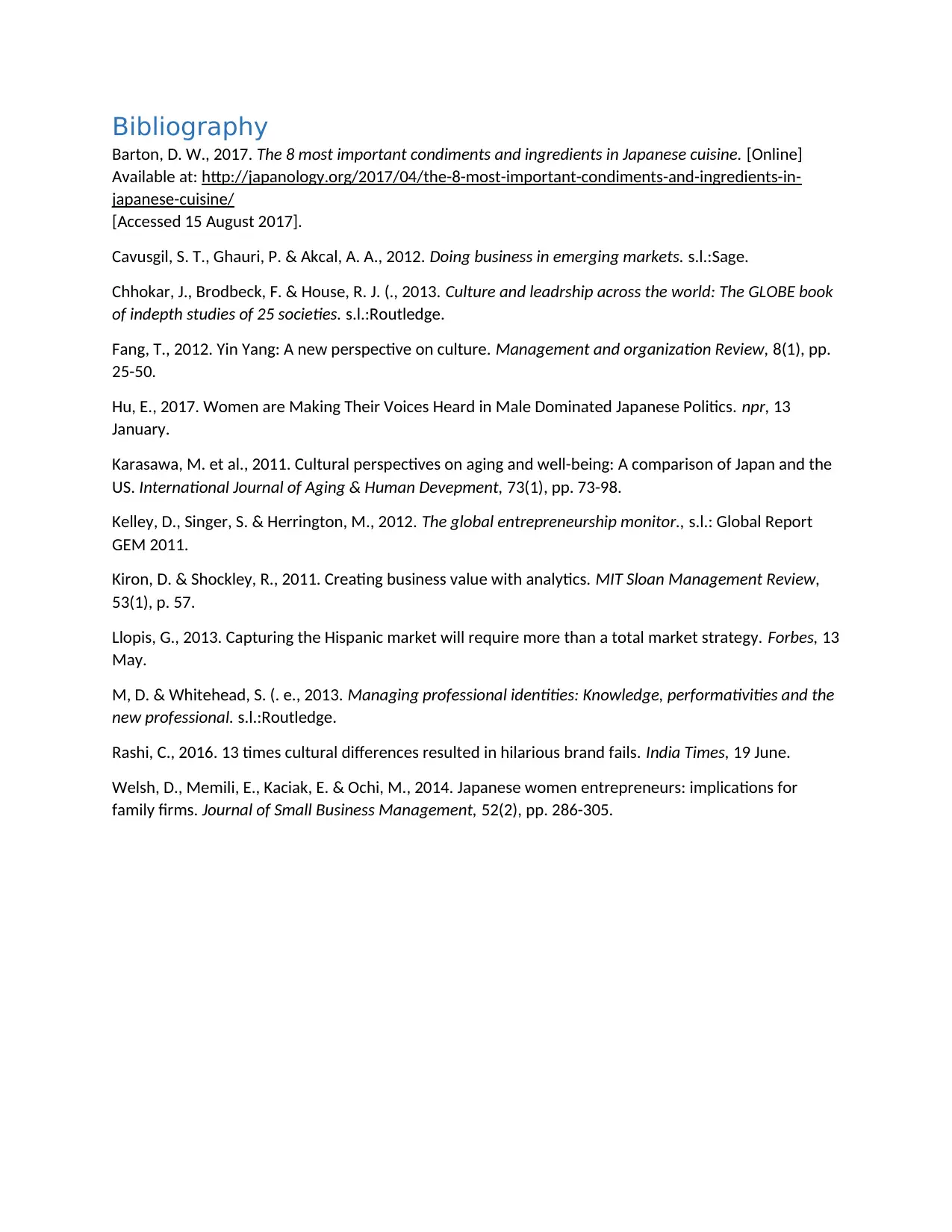
Bibliography
Barton, D. W., 2017. The 8 most important condiments and ingredients in Japanese cuisine. [Online]
Available at: http://japanology.org/2017/04/the-8-most-important-condiments-and-ingredients-in-
japanese-cuisine/
[Accessed 15 August 2017].
Cavusgil, S. T., Ghauri, P. & Akcal, A. A., 2012. Doing business in emerging markets. s.l.:Sage.
Chhokar, J., Brodbeck, F. & House, R. J. (., 2013. Culture and leadrship across the world: The GLOBE book
of indepth studies of 25 societies. s.l.:Routledge.
Fang, T., 2012. Yin Yang: A new perspective on culture. Management and organization Review, 8(1), pp.
25-50.
Hu, E., 2017. Women are Making Their Voices Heard in Male Dominated Japanese Politics. npr, 13
January.
Karasawa, M. et al., 2011. Cultural perspectives on aging and well-being: A comparison of Japan and the
US. International Journal of Aging & Human Devepment, 73(1), pp. 73-98.
Kelley, D., Singer, S. & Herrington, M., 2012. The global entrepreneurship monitor., s.l.: Global Report
GEM 2011.
Kiron, D. & Shockley, R., 2011. Creating business value with analytics. MIT Sloan Management Review,
53(1), p. 57.
Llopis, G., 2013. Capturing the Hispanic market will require more than a total market strategy. Forbes, 13
May.
M, D. & Whitehead, S. (. e., 2013. Managing professional identities: Knowledge, performativities and the
new professional. s.l.:Routledge.
Rashi, C., 2016. 13 times cultural differences resulted in hilarious brand fails. India Times, 19 June.
Welsh, D., Memili, E., Kaciak, E. & Ochi, M., 2014. Japanese women entrepreneurs: implications for
family firms. Journal of Small Business Management, 52(2), pp. 286-305.
Barton, D. W., 2017. The 8 most important condiments and ingredients in Japanese cuisine. [Online]
Available at: http://japanology.org/2017/04/the-8-most-important-condiments-and-ingredients-in-
japanese-cuisine/
[Accessed 15 August 2017].
Cavusgil, S. T., Ghauri, P. & Akcal, A. A., 2012. Doing business in emerging markets. s.l.:Sage.
Chhokar, J., Brodbeck, F. & House, R. J. (., 2013. Culture and leadrship across the world: The GLOBE book
of indepth studies of 25 societies. s.l.:Routledge.
Fang, T., 2012. Yin Yang: A new perspective on culture. Management and organization Review, 8(1), pp.
25-50.
Hu, E., 2017. Women are Making Their Voices Heard in Male Dominated Japanese Politics. npr, 13
January.
Karasawa, M. et al., 2011. Cultural perspectives on aging and well-being: A comparison of Japan and the
US. International Journal of Aging & Human Devepment, 73(1), pp. 73-98.
Kelley, D., Singer, S. & Herrington, M., 2012. The global entrepreneurship monitor., s.l.: Global Report
GEM 2011.
Kiron, D. & Shockley, R., 2011. Creating business value with analytics. MIT Sloan Management Review,
53(1), p. 57.
Llopis, G., 2013. Capturing the Hispanic market will require more than a total market strategy. Forbes, 13
May.
M, D. & Whitehead, S. (. e., 2013. Managing professional identities: Knowledge, performativities and the
new professional. s.l.:Routledge.
Rashi, C., 2016. 13 times cultural differences resulted in hilarious brand fails. India Times, 19 June.
Welsh, D., Memili, E., Kaciak, E. & Ochi, M., 2014. Japanese women entrepreneurs: implications for
family firms. Journal of Small Business Management, 52(2), pp. 286-305.
1 out of 7
Related Documents
Your All-in-One AI-Powered Toolkit for Academic Success.
+13062052269
info@desklib.com
Available 24*7 on WhatsApp / Email
![[object Object]](/_next/static/media/star-bottom.7253800d.svg)
Unlock your academic potential
Copyright © 2020–2025 A2Z Services. All Rights Reserved. Developed and managed by ZUCOL.





